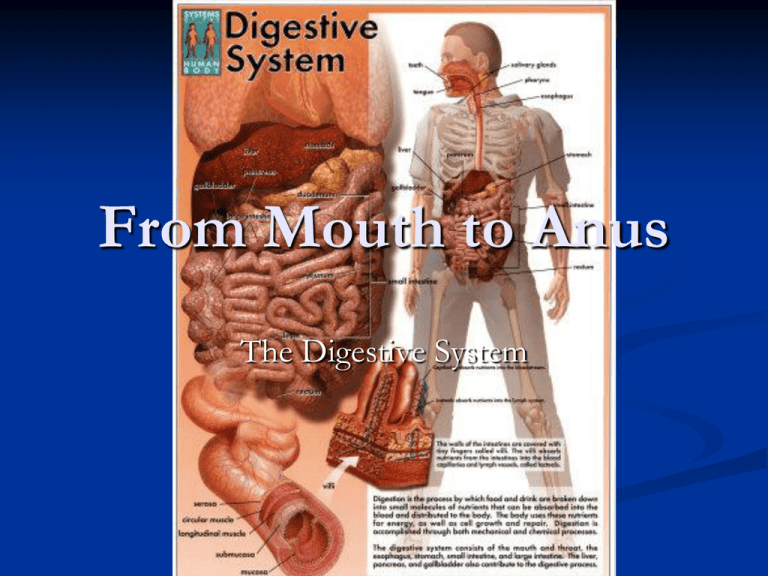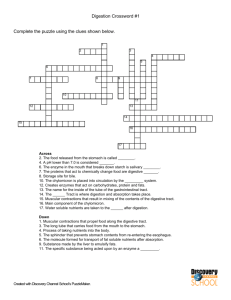From Mouth to Anus - Sun Prairie Area School District
advertisement

From Mouth to Anus The Digestive System Challenges Food Presents all animals with at least two challenges: 1. 2. How to obtain it? How to break food down into small molecules that can be passed to cells that need them? Function To help convert foods into simple molecules that can be absorbed and used by the cells of the body. The digestive system is built around an alimentary canal a one-way tube that passes through the body. This is also known as the Gastro Intestinal Tract (G.I. Tract) Anatomy and Physiology of the G.I. Tract Mouth (oral cavity): place where food enters; mechanical and chemical digestion begins Tongue: moves food around, pushes it to back of the mouth for swallowing, clump of food is then called a bolus. Teeth (mechanical): breaks down food into smaller particles to increase surface area for chemical digestion A & P of G.I. Tract Salivary Glands (chemical): secretes saliva, which contains an enzyme called amylase. Salivary amylase breaks down starch into disaccharides. A & P of the G. I. Tract Esophagus: muscular tube that connects the mouth to the stomach Peristalsis: wave-like motion that pushes food down A & P of G.I. Tract Stomach: HCl and pepsin break down proteins. Lined with mucus so that it doesn’t digest itself Stomach muscles contract to mix food into chyme. Food stays here 2-4 hours A & P of G.I. Tract Small Intestine: approx. 6 meters long Made of three sections: duodenum, jejunum, ileum Most important digestive organ, as digestion of carbs, fats, and proteins is completed here. Also the site of nutrient absorption (villi and capillaries) A & P of G.I. Tract Large intestine a.k.a. “COLON” Approx. 1.5 meters long Site of water absorption Leaves behind solid material called feces Food stays here 18-24 hours Not enough water absorbed= diarrhea Too much water absorbed= constipation A & P of G.I. Tract Rectum: stores solid waste until appropriate time for removal Anus: solid waste exits through this opening Entire journey takes approx. 24-33 hours ACCESSORY TO DIGESTION These structures are NOT a part of the G.I. Tract, food does NOT travel here! LIVER: produces bile, which helps break down fats GALLBLADDER: stores bile Accessory to Digestion CBD: common bile duct, transfers digestive juices from liver, pancreas, and gallbladder to the small intestine Pancreas: secretes fluid to help breakdown fats, carb’s, and proteins in the small intestine. Digestive System Anatomy Quiz 1. Where does digestion begin? 2. What is the name of the tube that connects the mouth to the stomach? 3. What enzyme does your salivary glands secrete? 4. What is the name of the wave-like motion that pushes food throughout the G.I. Tract? 5. In which organ does nutrient absorption take place? 6. In which organ does water absorption take place? QUIZ 7. Trace the pathway a hamburger will travel, from the mouth to the anus. Hint: You should include 7 structures. 8. What is the function of the liver? 9. In which organ do the digestive juices work in? 10. What organic compound does your stomach start breaking down? 11. Where are carbohydrates broken down? Careful! 12. How do nutrients get from the small intestine to the bloodstream? ANSWERS 1. Mouth 2. Esophagus 3. Amylase 4. Peristalsis 5. Small intestine 6. Large intestine 7. Mouth esophagus stomach s.intestine l.intestinerectum anus 8. Produce bile 9. Small intestine 10. Proteins 11. Mouth and small intestine 12. Villi, capillaries









